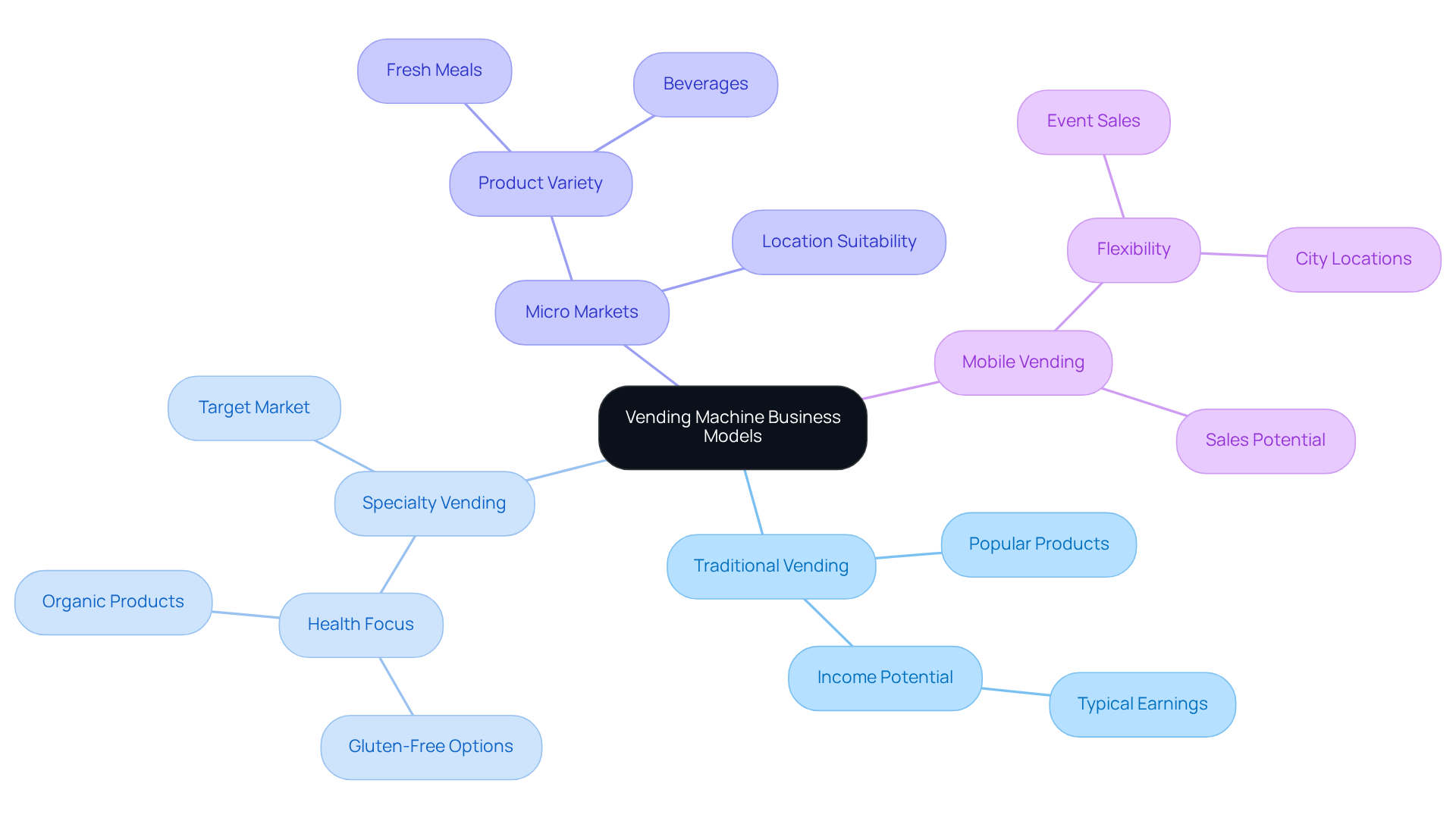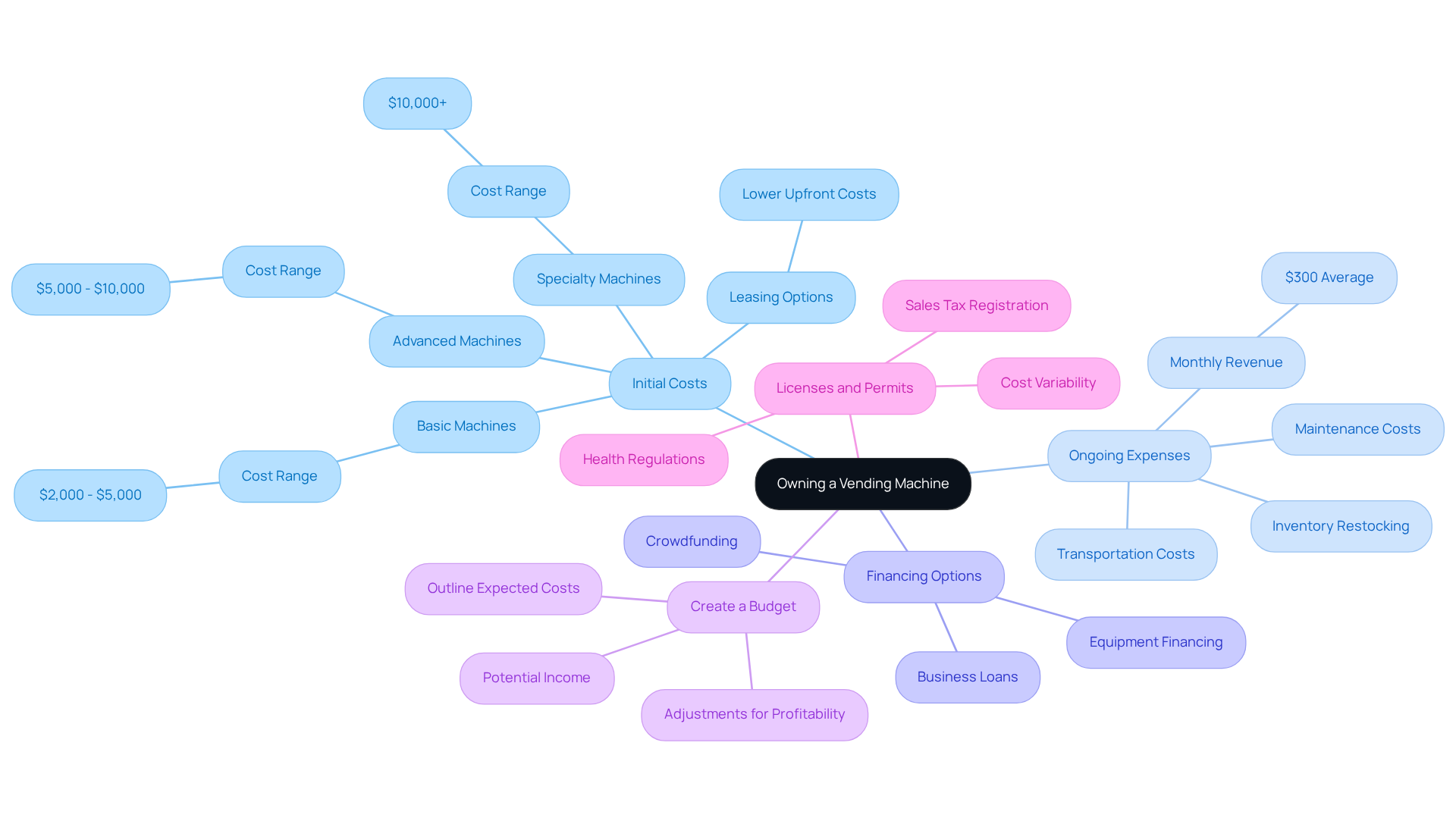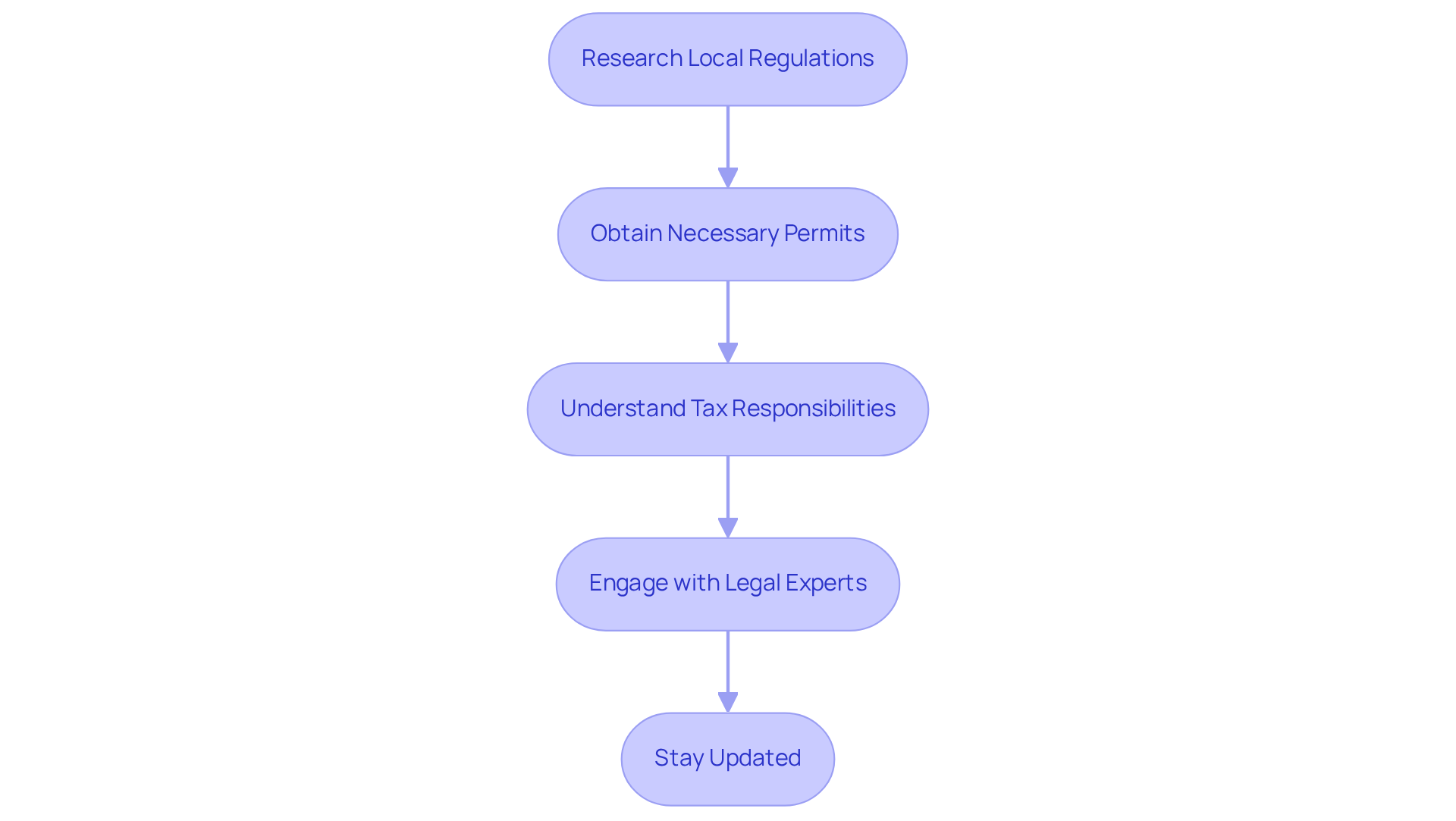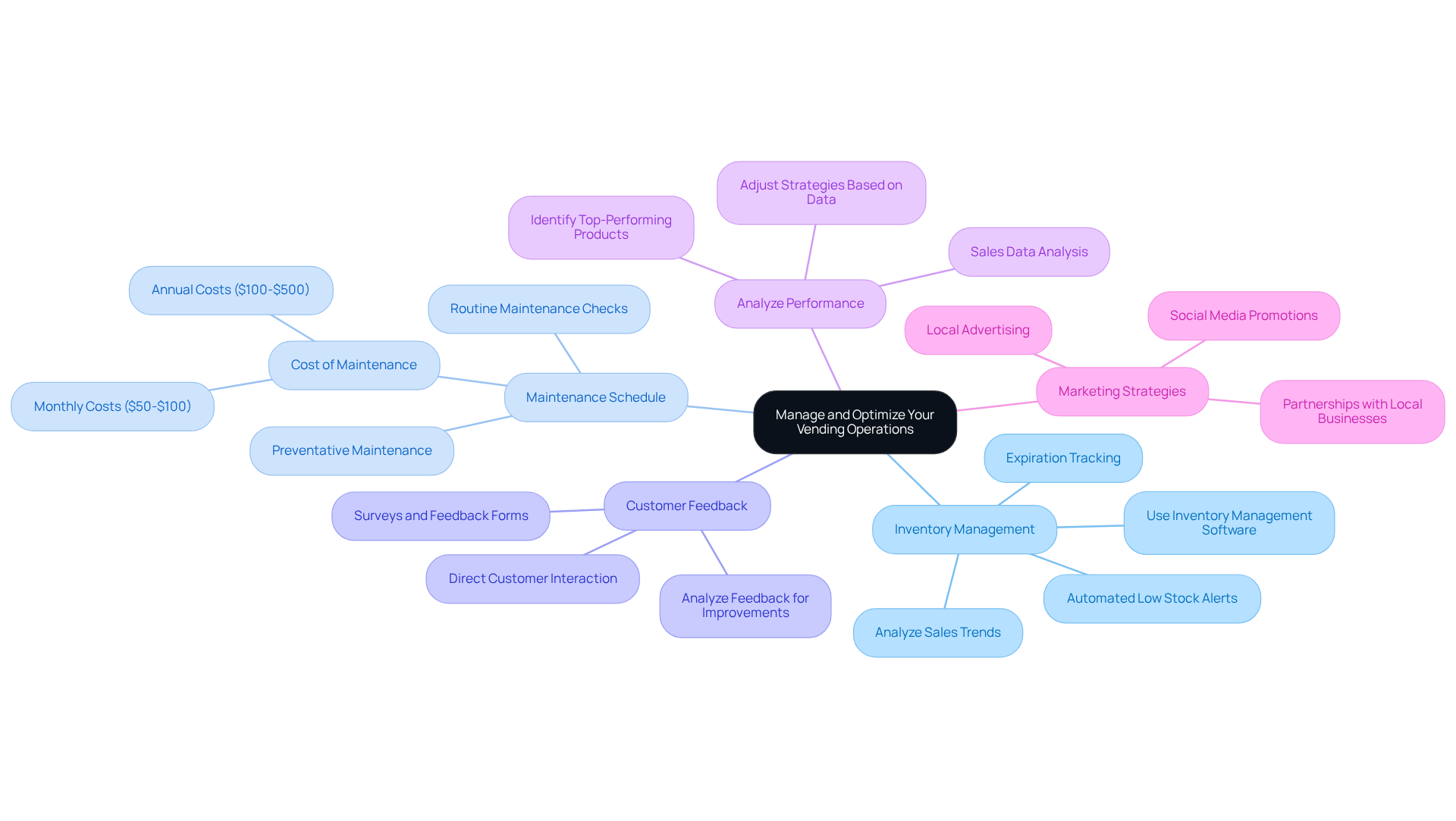Overview
Thinking about owning a vending machine in California? You’re not alone! It’s a pretty exciting venture, but there are some essential steps you’ll want to keep in mind.
- First off, you’ll need to define your business model. What kind of snacks or drinks do you want to offer?
- Next, securing prime locations is key. You want spots where people are likely to buy from you.
- Assessing costs is also crucial — you don’t want any surprises down the road.
Now, let’s talk about the legal stuff. Navigating those requirements might feel a bit overwhelming, but it’s necessary to keep everything on the up and up. And don’t forget about optimizing your operations. That’ll help your business run smoothly.
Here’s the thing: understanding the market is vital. You’ll want to manage your inventory effectively and stay compliant with local regulations. These are the building blocks for a successful vending machine business in California.
So, what’s your next step? Dive into those aspects, and you’ll be well on your way to making your vending machine dreams a reality!
Introduction
Have you ever thought about the world of vending machines in California? It's a vibrant industry full of opportunities for those looking to dive in. There’s everything from traditional snack dispensers to innovative micro markets, giving you plenty of ways to cater to health-conscious folks and busy professionals.
But here's the thing: as the automated retail sector keeps growing, you might wonder how to navigate the ins and outs of starting and running a vending machine business while staying compliant and profitable.
This guide is here to help! We’ll break down the essential steps to successfully own and operate a vending machine venture in California. You’ll get valuable insights into picking the right locations, managing costs, and understanding legal requirements.
So, let’s get started!
Define Your Vending Machine Business Model
When you're considering how to own a vending machine in California, it's super important to look into the different models out there.
-
Traditional Vending is the classic choice. You place machines in busy spots and fill them with popular snacks and drinks. These machines have been around forever and still pull in a good income—think about it, a typical unit can earn over $300 a month!
-
Then there’s Specialty Vending. This one targets specific markets, offering healthier options like gluten-free snacks or organic products. As more people lean towards healthier eating, these specialty machines are really starting to take off, appealing to those health-conscious folks out there.
-
Next up is Micro Markets. These self-service kiosks provide a wider range of products, including fresh meals and drinks, and you’ll often find them in office buildings. They’re perfect for meeting the demand for quick meal options, making customers happy and satisfied.
-
Let’s not forget about Mobile Vending. With food trucks or portable vending machines, you can reach customers at events, festivals, or in busy city areas. This model gives you flexibility and the chance for big sales during peak times.
So, how to own a vending machine in California is the right question to ask when choosing the right model? It’s all about finding one that fits your interests and doing some solid market research. Make sure it meets the needs of your target audience. And don’t forget to write down your chosen model in a detailed business plan—it’ll help clarify your vision and strategy.
With the automated retail sector expected to grow at a compound annual growth rate of 3.2% from 2025 to 2033, now’s a great time to jump into this expanding industry!

Identify and Secure Prime Vending Locations
Looking to find and secure the best vending spots? Here are some straightforward steps to help you out:
-
Research High-Traffic Areas: Think about places like schools, hospitals, office buildings, and gyms. These spots usually see a lot of foot traffic. A well-placed machine can rake in 2-3 times the income compared to one in a less busy area.
-
Network with Property Managers: Building good relationships with property managers is key. They can give you the lowdown on available spaces and what the property really needs. When you engage with them, you’re likely to strike mutually beneficial deals since they want to keep tenants happy and boost their income too.
-
Evaluate Competition: Take a good look at the automated retail scene in potential locations. This will help you understand demand and how many competitors are out there. Knowing the competitive landscape allows you to position your offerings smartly and spot any gaps in the market.
-
Negotiate Terms: Once you find a great spot, it’s time to negotiate lease terms that work for both sides. Offering a percentage of sales to the property owner can be a win-win, creating a collaborative partnership. For example, one savvy operator proposed a 10% revenue share to a property manager, which led to a successful long-term relationship.
-
Secure Permits: Don’t forget to check local regulations. Make sure you get all the necessary permits and licenses to operate where you want. This step is crucial to understand how to own a vending machine in California, helping you avoid any legal headaches down the road and keep your operations running smoothly.

Assess Costs and Explore Financing Options
If you're thinking about how to own a vending machine in California, it's essential to get a handle on costs and financing options. Here’s a straightforward breakdown to help you out:
Initial Costs: First off, you’ll want to figure out the expenses tied to buying or leasing vending machines, stocking them up, and finding great locations. Generally, you’re looking at an initial investment between $5,000 and $15,000, depending on the type and features of the machines you choose. For instance, basic models can start around $2,000, while more advanced options might set you back between $5,000 and $10,000.
Ongoing Expenses: Don’t forget about ongoing costs! You’ll need to budget for inventory restocking, maintenance, and transportation. Monthly expenses can really vary based on how much you use the machines and how popular the spots are. Typically, a snack dispenser can pull in over $75 a week, which adds up to about $300 a month. But keep in mind, this can change based on foot traffic and what products you offer.
Financing Options: Now, let’s talk financing. There are several ways to fund your vending machine venture:
- Business Loans: Traditional loans from banks or credit unions can give you the cash you need.
- Equipment Financing: These are specialized loans designed for buying vending machines, helping you manage costs effectively.
- Leasing: Leasing machines can lower your upfront costs, making it easier on your wallet.
- Crowdfunding: You might also consider crowdfunding to gather support from your community or potential customers.
Create a Budget: Next up, it’s time to create a budget. Outline all your expected costs and potential income. This step is crucial for ensuring you stay financially viable and helps guide your decisions. A well-structured budget will help you keep tabs on your income and expenses, allowing you to make adjustments to maintain profitability.
Licenses and Permits: Lastly, don’t overlook the need for licenses and permits. These can vary in cost and requirements depending on where you’re located. This is a key aspect of launching your vending business and learning how to own a vending machine in California that should be included in your financial planning.

Navigate Legal Requirements and Compliance Standards
If you're considering how to own a vending machine in California, you’ll want to make sure you’re on top of the legal stuff. Here’s how to get started:
-
Research local regulations. It’s super important to know the specific laws in your area that govern vending operations, including health and safety rules. Each county can have its own quirks, so check in with local agencies to get the scoop.
-
You’ll need to obtain the necessary permits. This usually means applying for a seller's permit, which is a must for sales from vending machines. The good news? In California, you only need one seller's permit, no matter how many machines you have. If you’re planning to sell food, you might also need health permits, depending on local laws. Budget around $250 for licenses and permits to kick off your snack vending business.
-
Now, let’s talk about understanding tax responsibilities. You’ll want to familiarize yourself with the sales tax rules for vending transactions. California does impose a sales tax on automatic merchandise dispensers, so make sure you’re following both state and local tax regulations to avoid any nasty penalties.
-
It’s also a smart move to engage with legal experts. They can really help you navigate the maze of permits and compliance. Think of them as your go-to advisors for avoiding common pitfalls and figuring out the best ways to keep your business compliant.
-
Finally, make it a habit to stay updated. Regulations can change, and you don’t want to be caught off guard. Joining local retail associations or forums can be a great way to stay in the loop about industry standards and legal updates. Plus, having those legal experts in your corner can provide valuable insights.
By following these steps, you’ll be well on your way to learning how to own a vending machine in California legally and successfully. It’s all about minimizing risks and maximizing your chances of success!

Manage and Optimize Your Vending Operations
To effectively manage and optimize your vending operations, let’s explore some straightforward strategies that can make a real difference:
-
Inventory Management: Think about using inventory management software to keep tabs on stock levels and sales trends. This tech can help you ensure that popular items are always available, meeting customer demand without a hitch. Plus, automated systems can alert you when stock is low or items are nearing expiration. With the Vending Management System (VMS) market expected to grow at a CAGR of 5.6% from 2025 to 2033, it’s clear that effective management is crucial in this expanding landscape.
-
Maintenance Schedule: Establishing a routine maintenance schedule is key. Regular upkeep keeps your machines clean and running smoothly. Typically, these checks cost between $50 and $100 a month, but they can save you from expensive repairs and downtime. Annual maintenance might set you back anywhere from $100 to $500, but it’s worth it to extend your equipment’s lifespan and keep customers happy with reliable service.
-
Customer Feedback: Have you considered actively seeking customer feedback? It’s a great way to identify areas for improvement. Using surveys or just chatting with customers can provide valuable insights into their preferences, helping you tweak your offerings and enhance their overall experience.
-
Analyze Performance: Regularly dive into your sales data to pinpoint which locations and products are performing well. This analysis can guide you in making strategic adjustments to align with what customers want, ultimately maximizing your profits. For example, operators often see a positive return on investment within 12 to 24 months after implementing effective inventory management practices. As Zachary Crockett noted, the typical per-unit margins for various automated retail goods show significant profitability across categories, underscoring the importance of solid inventory management.
-
Marketing Strategies: Let’s talk marketing. Boost the visibility of your machines with targeted efforts. Think social media, local ads, or partnerships with nearby businesses to draw in more customers. Engaging marketing can really ramp up foot traffic and sales, contributing to your vending operation's success. And don’t forget to look into automated solutions for tracking expiration dates and real-time monitoring to further optimize inventory management and cut down on waste.

Conclusion
Owning a vending machine business in California can really be a rewarding venture, especially if you come at it with the right knowledge and strategy. Think about it: understanding the different business models, pinpointing the best locations, keeping an eye on costs, navigating legal requirements, and optimizing operations can help you carve out a niche in this growing industry.
So, what are the essential steps? First off, you’ll want to define your vending model—whether it’s traditional, specialty, micro markets, or mobile vending. And don’t underestimate the importance of securing high-traffic locations. Building good relationships with property managers and knowing the competitive landscape can make a huge difference.
Plus, managing costs and exploring financing options are key. You’ve got to ensure you’re compliant with local regulations too. It might sound like a lot, but breaking it down makes it manageable.
Here’s the thing: the vending machine industry is full of potential, especially as more consumers lean towards convenience and healthier options. If you’re thinking about diving in, conducting thorough market research is a must. Stay informed about industry trends and be ready to adapt your strategies to meet customer demands.
By following these guidelines, you can successfully navigate the path to vending machine ownership in California. It’s all about contributing to a thriving automated retail landscape. So, are you ready to take that first step?
Frequently Asked Questions
What are the different vending machine business models available?
The main vending machine business models include Traditional Vending, Specialty Vending, Micro Markets, and Mobile Vending. Traditional Vending involves placing machines in busy areas with popular snacks and drinks. Specialty Vending focuses on healthier options. Micro Markets are self-service kiosks offering a wider range of products, including fresh meals. Mobile Vending uses food trucks or portable machines to reach customers at events and busy locations.
How much can a traditional vending machine earn?
A typical traditional vending machine can earn over $300 a month.
What is the significance of market research when choosing a vending machine model?
Conducting solid market research helps ensure that the chosen vending machine model meets the needs of the target audience, making it crucial for success in the vending business.
What steps can I take to identify prime vending locations?
To identify prime vending locations, research high-traffic areas such as schools, hospitals, office buildings, and gyms. Network with property managers to learn about available spaces, evaluate competition in potential locations, negotiate favorable lease terms, and secure necessary permits.
Why is networking with property managers important?
Networking with property managers is important because they can provide insights on available spaces and the needs of the property. Building good relationships can lead to mutually beneficial deals that enhance tenant satisfaction and boost income.
How can I negotiate lease terms for a vending machine location?
When negotiating lease terms, consider offering a percentage of sales to the property owner, which can create a collaborative partnership. For example, proposing a 10% revenue share can lead to a successful long-term relationship.
What should I check regarding permits when starting a vending machine business in California?
It is crucial to check local regulations and obtain all necessary permits and licenses to operate a vending machine in California to avoid legal issues and ensure smooth operations.
List of Sources
- Define Your Vending Machine Business Model
- U.S. Retail Vending Machine Market | Industry Report, 2033 (https://grandviewresearch.com/industry-analysis/us-retail-vending-machine-market-report)
- Vending Machine Statistics and Facts (2025) (https://news.market.us/vending-machine-statistics)
- How Profitable Are Vending Machines? | Nayax (https://nayax.com/blog/how-profitable-are-vending-machines)
- United States Vending Machine Market Analysis 2025 (https://renub.com/united-states-vending-machine-market-p.php)
- United States Vending Machine Market, Size, Future, Growth, Trends Outlook 2032 (https://marketsandata.com/industry-reports/united-states-vending-machine-market)
- Identify and Secure Prime Vending Locations
- DFY Vending's Ultimate Guide to High-Profit Machine Locations (https://dfyvending.com/high-profit-vending-locations)
- How to Identify High Traffic Vending Machine Locations for Maximum Profit - Vending Locator (https://vendinglocator.com/blog/high-traffic-vending-machine-locations)
- The Ultimate Guide to Finding Profitable Vending-Machine Locations | VendSoft (https://vendsoft.com/profitable-vending-machine-locations-guide)
- Top Vending Machine Locations for Success in 2025 (https://dfyvending.com/optimal-vending-machine-locations-2025)
- Vending Machine Statistics and Facts (2025) (https://news.market.us/vending-machine-statistics)
- Assess Costs and Explore Financing Options
- Total Cost To Start A Vending Machine Business In 2025 | Best Guide (https://vendingvenue.com/2025/05/28/vending-machine-business-in-2025)
- How to Start a Vending Machine Business: Cost, Tips, Pros and Cons - NerdWallet (https://nerdwallet.com/article/small-business/how-to-start-a-vending-machine-business)
- How Much Do Vending Machines Cost? (2025) | Naturals2Go (https://naturals2go.com/vending-machine-cost)
- Start a vending machine business: Steps for 2025 | Swoop US (https://swoopfunding.com/us/start-a-business/vending-machine-business)
- Is It Expensive to Own a Vending Machine? The Complete 2025 Cost Breakdown (https://cottoncandyvending.com/is-it-expensive-to-own-a-vending-machine-the-complete-2025-cost-breakdown)
- Navigate Legal Requirements and Compliance Standards
- 50-State Vending Machine Laws & Permits Directory | VendSoft (https://vendsoft.com/resources/vending-laws)
- Vending Machine Statistics in 2023 - Vending Locator (https://vendinglocator.com/blog/vending-machine-statistics)
- Sales And Use Tax Law - Section 6359.4 (https://cdtfa.ca.gov/lawguides/vol1/sutl/6359-4.html)
- Vending Machine Food Sales (Publication 118) (https://cdtfa.ca.gov/formspubs/pub118)
- Vending Machine Operators in California - Market Research Report (2015-2030) | IBISWorld (https://ibisworld.com/united-states/industry/california/vending-machine-operators/14777)
- Manage and Optimize Your Vending Operations
- The Truth About Vending Machine Maintenance Costs and Preventative Servicing (https://dfyvending.com/vending-machine-maintenance-costs)
- Vending Machine Statistics and Facts (2025) (https://news.market.us/vending-machine-statistics)
- Vending Management System (VMS) 2025-2033 Analysis: Trends, Competitor Dynamics, and Growth Opportunities (https://archivemarketresearch.com/reports/vending-management-system-vms-14503)
- 8+ Best Vending Machine Inventory Software Solutions (https://ddg.wcroc.umn.edu/vending-machine-inventory-management-software)
- Emerging Market Insights in Vending Machine Management Software: 2025-2033 Overview (https://datainsightsmarket.com/reports/vending-machine-management-software-1987183)




